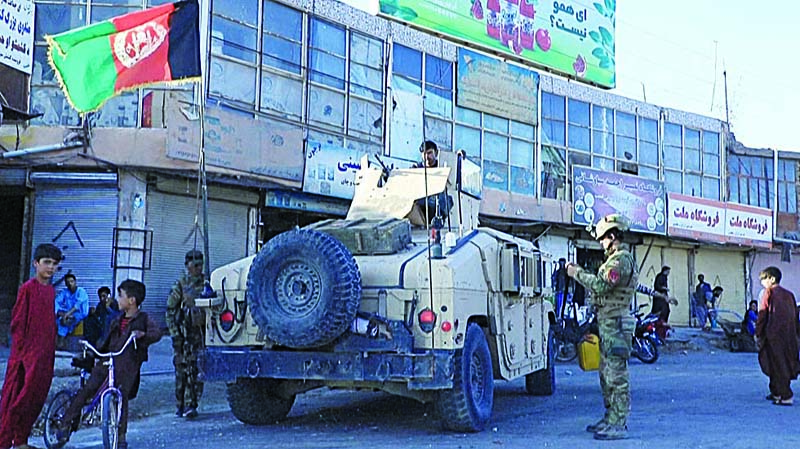 HERAT: This video screen grab from AFPTV shows Afghan special forces patrol the streets of Herat as the Taleban continue a series of offensives against urban areas in Afghanistan Tuesday. - AFP
HERAT: This video screen grab from AFPTV shows Afghan special forces patrol the streets of Herat as the Taleban continue a series of offensives against urban areas in Afghanistan Tuesday. - AFPHERAT: Trained by the United States and equipped with state-of-the-art gear, Afghanistan's special forces are its frontline weapon against the Taleban, but reduced American military support has stretched them to breaking point. With the US troop presence in Afghanistan effectively over, an accelerated Taleban offensive has gobbled up vast tracts of rural territory and laid siege to cities held by government forces. The speed and scope of the campaign have placed enormous strain on the elite units, who have been constantly shuttled to hot spots where regular forces have buckled under the Taleban assault.
The head of Special Operations Command, Major General Haibatullah Alizai, says sharply diminished US air support has hindered operations. "It's more challenging these days. While we are fighting in most areas, on some frontlines, it is getting difficult. But we have no choice-it's our country," Alizai told AFP. The brutal killing of an elite group of special forces in June, after reinforcements failed to materialize, was a stark illustration of how squads can swiftly find themselves isolated and overrun.
'Never lost a battle'
Sporting night-vision goggles, US-made rifles and other modern combat equipment, Afghanistan's special forces stunned the Taleban when they first emerged in 2008. Their American trainers hailed them as a force to be reckoned with that could, eventually, help the Afghan government eradicate the Taleban and speed a US exit. "The special operations in Afghanistan have been uniquely created in our own image," Todd Helmus, a RAND Corporation analyst who spent time with soldiers on the ground in 2013, told AFP.
"They're very good. They're very well trained. They know how to shoot, move, and communicate." In a country where training for local soldiers has often been rudimentary, drills for special forces were intense: 14 weeks of marksmanship, squad tactics, air assault, and live-fire exercises. Private contractors played a role. A now-expired online job ad by US defense giant Raytheon sought candidates to "organise, man, equip, and train" the Ktah Khas (KKA) -- one of the most elite special forces divisions made up of army, police, and intelligence agency units. Within a decade their numbers had ballooned-precise figures are classified, but two security sources told AFP there were around 56,000 special forces across the army, police, and intelligence services.
"These brave soldiers have never lost a battle. And they never will," then-commander of US forces in the country General John Nicholson said in 2017, the same year the elite unit grabbed headlines for its role in the killing of Abdul Hasib, the head of the Islamic State group in Afghanistan.
But while Major General Alizai told AFP they are now trained by other Afghans, analysts argue the special forces were always overly dependent on foreign assistance-from intelligence gathering to logistics-leaving them fundamentally vulnerable to a US and NATO pullout. "We're seeing the failure of that policy, now there's a natural recognition that obviously we need to train these units to fight on their own, so they don't need us anymore," RAND's Helmus said.
'Abandoned'
With the US withdrawal nearly complete, the elite units have become a last line of defense against sweeping Taleban advances. "The only thing that's degrading the Taleban's progress right now are the special forces and the air force," Vanda Felbab-Brown, a senior fellow at the Brookings Institution, told AFP. "And they are being overused, they are just being parachuted from one crisis area to another-suppressing the fire without putting out the fire."
Recent rapid deployments have defended Qala-i-Naw, the first provincial capital attacked by the Taleban since foreign forces began their pullout in May, as well as southern Kandahar and western Herat, to prevent the fall of provincial capitals there. In these hot spots, special forces have often found themselves over-stretched and without local reinforcement.
In June, a unit of around two dozen special forces -- sent to reinforce a flagging local defense-was overwhelmed by the Taleban in the northern province of Faryab. Footage posted online appeared to show them being executed after surrendering. Among those killed was Major Sohrab Azimi, a rising star in the Afghan army whose death prompted an outpouring of public anger over perceived military incompetence.
Taleban territorial gains have raised doubts about the Afghan military's strength with foreign troops all but gone-a showdown between two very different forces in which experts say morale could be as decisive as equipment and personnel. It is not a conventional military engagement, but one that pits a large army-raised and equipped by a superpower-against a smaller but well-supplied jihadist group backed by narco-dollars.
The United States has poured tens of billions of dollars into Afghanistan's defense forces, providing modern weapons and high-tech equipment, including night-vision goggles, attack helicopters, armored vehicles and surveillance drones. With more than 300,000 personnel-police included-it is bigger and more advanced than the Taleban, who are mainly a guerrilla infantry with no air force. UN monitors estimated last year the insurgents had between 55,000 and 85,000 fighters. But numbers alone do not tell the whole story.
'Propped up on a stick'
The Taleban mainly use weapons found easily in war-torn Afghanistan or procured from the black market, such as variants of the AK-47 assault rifle and other Soviet-designed arms. They have also captured Western-made weapons and equipment from the Afghan military, and have allegedly received material and advisory support from regional powers such as Iran and Pakistan. "The style of fighting they employ is a lot less logistically intensive," said Jonathan Schroden, a counterterrorism expert at the military think tank CNA. - AFP










